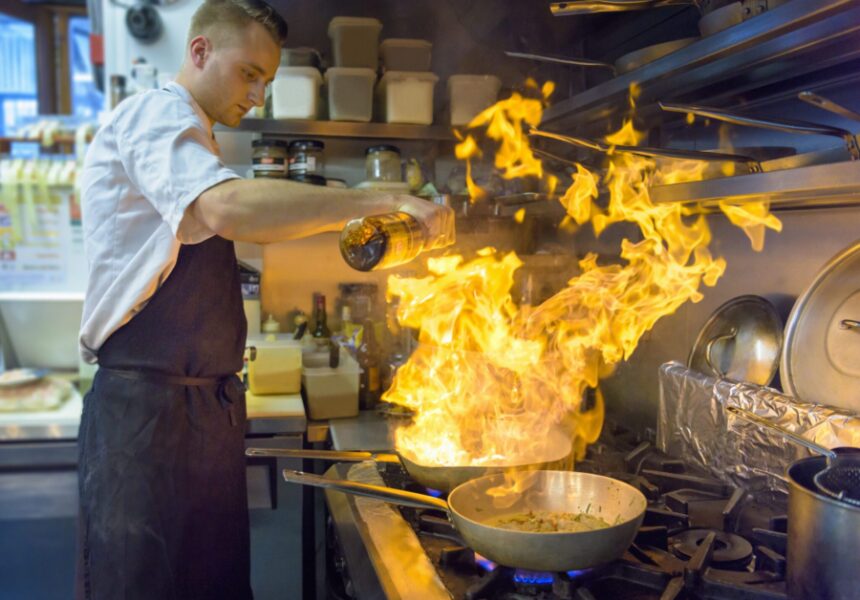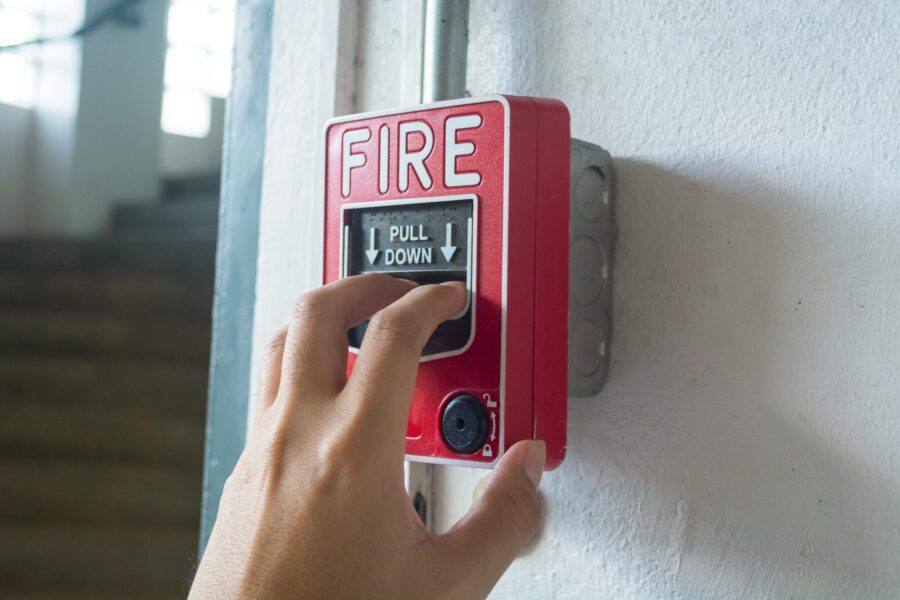Fire safety is an essential consideration for any restaurant owner. Even a small fire can cause enough damage to a building and furnishings to shut down a restaurant, and fire represents a serious threat to the safety of restaurant staff and patrons.
Twenty Restaurants Burn Every Day
According to restaurant fire safety data compiled by the National Fire Protection Association, fire departments around the nation report about 20 restaurant fires every day, with resulting losses adding up to an average of $165 million every year in fire damage.
Just as serious as the costs of property damage and business interruption are the risks of liability, should a worker or patron suffer an injury.
In this article, we will take a close look at how restaurant owners can develop a fire safety checklist manage these risks, without slowing down a healthy and growing foodservice business.
Install Smoke Detectors
Smoke detectors have saved thousands of lives by alerting homeowners to the presence of fire, and they can be just as valuable to restaurant fire safety, sounding a warning before smoke can be seen or smelled.
Smoke detectors are a low-cost form of excellent fire protection. They should be installed throughout an establishment, in the kitchen, dining rooms, pantry, storage areas and restrooms. Change batteries regularly to keep smoke alarms on guard.
Install Fire Alarms
Alarms are essential for alerting staff and patrons to the presence of fire. A fire alarm system can be automatic, with audible and light alarms triggered by smoke detectors, or they can be manual, triggered when a worker or patron pulls a handle.
Restaurant owners and managers should become familiar with Chapter Nine of the NFPA Life Safety Codes, which specify the right types of alarms for restaurant fire safety, based on restaurant type, size and operations.
For example, a dining room with capacity of more than 300 should have a system with both an audible siren alarm and strobing lights. Fire safety equipment providers such as Honeywell and Siemens can recommend appropriate systems for restaurants of any size.
When alarm systems are already in place, managers should test alarms regularly to ensure that they are in good working order.
Keep Fire Extinguishers Ready
At minimum, even the smallest restaurant should have a Class K fire extinguisher readily accessible in the kitchen and managers should make sure that all staff members know when and how to use it.
Fortunately, about 68 percent of kitchen fires are small enough to be put down without major damage using portable fire extinguishers. Fire extinguishers play a front-line role in restaurant fire safety.
Portable fire extinguishers are charged with pressure to deliver their contents, and they should be checked regularly to ensure good working order. Close attention must be paid to charge pressures, as well as actuation components such as pull handles and triggers.
Sprinkler Protection
Although sprinkler systems have not been a traditional component of restaurant fire safety, many new commercial buildings are requiring sprinklers, depending on the other uses of the building.
For example, a restaurant that also houses a night club or discotheque may be required to have a sprinkler system for fire safety.
One advantage of sprinkler systems is that they are fully automatic, providing both fire warning and fire suppression, even when the building is empty.
Rather than reacting to smoke or flame, as some alarm systems do, a fire sprinkler system responds when heat rise at any one of the sprinkler heads reaches 165 degrees Fahrenheit.
Automatic Fire Suppression System
A common fire risk is the accumulation of oils and fats on cooking equipment that causes grease fires. At sufficient temperature, these substances represent excellent fuel, and combined with airflow at a ventilation hood, they can easily start a fire.
Kitchen hoods are often equipped with fire suppression systems to smother grease fires by releasing a wet chemical suppressant, either when triggered automatically or when a handle is pulled by a kitchen worker.
Kitchen fire suppression systems should be regularly cleaned and inspected to prevent loss of function through accumulation of cooking grease or food debris.
Multiple Means of Egress
One of the most important concepts in fire safety is knowing how to get away from the fire. The NFPA Life Safety Code provides detailed recommendations for ensuring that a restaurant has multiple means of egress (a minimum of two) in every building. This does not include escaping through a storeroom or restroom.
If there are only two exits, one emergency must not be able to block both. Egress points must remain unobstructed at all times during normal restaurant operations, and accessible for a patron with limited mobility, for example, wide enough for someone seated in a wheelchair. Exits and routes to exits must be visible from anywhere in the restaurant.
Evacuation Training
In an emergency, the staff in a restaurant must know to operate somewhat like the flight attendants on a commercial airplane. The staff should have a fire safety escape plan and should be ready to participate in the evacuation of both patrons and fellow workers in the event of a fire.
Owners should conduct unannounced fire drills and make sure that everyone knows what to do and where to go should a fire alarm sound. Training for fire safety, fire equipment and evacuation should be a standard part of all new staff orientation,
Equipment Maintenance
NFPA data shows that the majority of restaurant fires (over 60 percent) originate in the kitchen cooking equipment. This should be obvious, since the kitchen is where open flames are being used in food preparation and where hard-working fryers, grills, ovens, toasters and warmers are pushed to their limits every day.
To keep the kitchen safe, keep cooking equipment clean and well-maintained. Regularly inspect equipment connections to kitchen supplies of gas and electrical power.
Kitchen Maintenance
Keep the kitchen clean and orderly: The kitchen is one of the main areas of risk for a fire in a restaurant, as it is where flammable materials and open flames are used.
Make sure that the kitchen is kept clean and free of clutter, and ensure that all appliances and equipment are in good working order.
Kitchen Exhaust Systems
Fats, oils and grease that are captured by the heat and steam of cooking will rise easily into stove hoods and other kitchen exhaust systems. However, as they cool in the hood or vent, grease will accumulate on the cooler surfaces of the exhaust system. As dust is added to the deposits of grease, a potential fuel for fire is being created.
Have every exhaust system inspected regularly, including stove hoods, window fans and HVAC return vents. When a build-up of grease is found, a thorough cleaning is in order.
Flammable Materials
NFPA data show that in 43 percent of fire incidents, cooking materials provided the fuel that started the fire. Inspect kitchens and storage areas to ensure that flammable materials are stored safely.
Cooking oils and alcohol are flammable, as are many cleaning supplies used in the kitchen. Store these materials in designated areas away from heat sources and ensure that they have proper labels.
In addition to volatile materials such as cleaning products, consider that, whether in grease fires or an electrical fire, table linens and napkins provide excellent fuel. All flammable materials are fire hazards, so keep heat sources and electrical connections clear of anything that could burn.
Building Electrical Systems
Electrical distribution and lighting systems are among the leading sources of fire risk, causing about 9 percent of all restaurant fires. Worn or defective wiring can overheat or cause short circuits that can set fire to flammable material.
Owners and managers should regularly inspect and maintain electrical distribution panels and check outlets that supply power to cooking systems. Worn or defective components and wiring must be repaired or replaced as soon as they are discovered.
Heating Equipment
NFPA data show that another 9 percent of restaurant fires are caused by heating equipment. While central heating systems can be dangerous if poorly maintained, most heating system fires are caused by space heaters, water heaters and fireplaces.
Space heaters are often placed too close to flammable materials, gas or electric water heaters can malfunction, and even decorative fireplaces can ignite creosote buildup in a chimney or flue.
Heating equipment and chimneys should be inspected by a heating professional. Check to ensure that combustion products are being vented to the outside. If any member of the staff smells gas, have the warm air furnace or water heater inspected by a heating professional.
Flammable Materials
Keep flammable materials at least three feet away from heat sources. Make sure that flammable materials, such as curtains and tablecloths, are kept a safe distance away from heat sources, such as cooking equipment, warm air heating units, fireplaces and even candles.
Fireplaces add a nice ambience to a dining room. Make sure the fireplace has a screen to prevent sparks from escaping.
Remember that everything in the restaurant that is made of wood, fabric or plastic is flammable, as well as many of the liquids used in cooking and cleaning.
Smoking
Although smoking by patrons and workers continues to decline in popularity, a significant portion of restaurant fires (about 7 percent) are still caused by careless handling of smoking materials. Make sure that cigarette butts and ashes are not discarded in a trash can that might contain paper or other flammable material.
Vulnerability to Arson
Sadly, about 4 percent of restaurant fires are determined to have been set intentionally. Although it is not easy to prevent an arson fire, an outdoor video security system can help.
Keep the outdoor front and rear of the property well lit. Train employees to be watchful, and talk safety with neighboring businesses, who can agree to look out for each other.
Fire Safety Training
Post fire safety signs throughout the restaurant to remind staff and patrons of fire safety rules and evacuation procedures. Train staff on all fire safety procedures, including how to use a fire extinguisher and how to evacuate the restaurant in the event of a fire.
Make sure that staff know that location of first aid supplies and have received basic instruction on how to respond in an emergency. For example, a victim whose clothing is on fire should not run, but should be covered with a tablecloth or curtain and helped to the floor to smother flames.
A Culture of Fire Safety
By following these restaurant fire safety tips, as well as other guidelines that can be found in materials available from the National Fire Protection Association and many insurance companies, restaurants can significantly reduce the risk of a fire and ensure the safety of their staff and patrons.
While it may be impossible to completely eliminate the risk of fire, taking proactive steps to establish a culture of fire safety and create a fire safety checklist will reduce the risk of fire and will ensure that everyone is prepared in the event a fire does occur.







